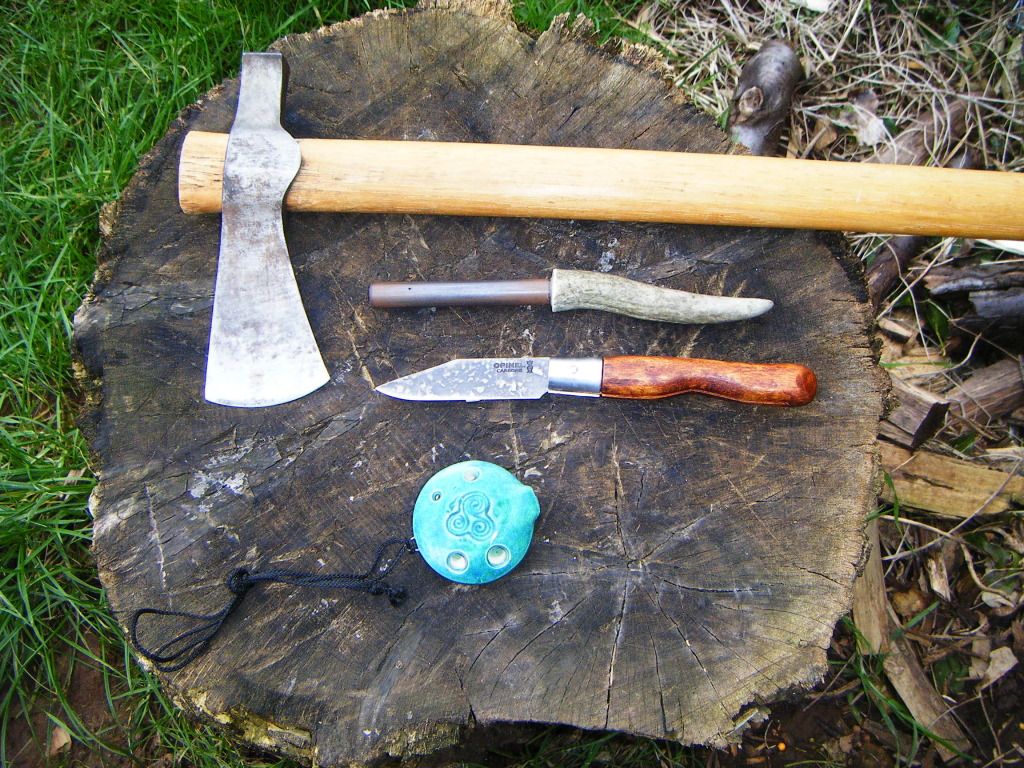Ok Here it is, excuse the crap pics!
Irish linen shirts (the second ones quite good even if I say so myself) and a heavy coarse linen smock, what developed into the hunting shirt but really was the common mans workware for farming, driving wagons, I gave it a cape to make iot a bit more water resistant. All buttons are bone, all hand sewn in linen thread. hooks and eyes copied from examples dug up in the US.
Wool and linen waistcoat in a style about right for the 1730s-1750s, wooden buttons covered in cloth. Top breeches also 1730s style Russian Drill hemp with linen lining. they are very heavy and too warm to work in (well potter around the garden) so I made a single layer pair from just linen and gave them a higher waist band so they stay up without braces. Again bone buttons.
heavy wool hunting shirt, far too hot to exert yourself in if you run hot like me, also makes me look like a pixie on steroids. made from the same pattern as the linen smock.
Whitney Blanket Capote by Smoke and Fire, I've used this a lot and love it to bits. Technically the style is later than the 1750s but what the heck, makes a great blanket.
various hats, a neckerchief from stripey cotton/linen made at the Queens Street Mill Museum over in Burnley. The Benny hats are styled on the Monmouth Cap in the Nelson Museum, made by herself. The brown one is made from super Chunky coloured ryeland wool, and is too warm to wear if its above freezing, the paler from chunky Jacob wool. the Balmoral is made from woolen cloth scrounged from Swandri as is the top 6 panel skull cap. The green 4 pannel one is lined with linen. We use up any off cuts making these things, the eldest son (14) is pretty adept at it now. Dark green Voyageurs hand knitted extra big by someones granny At Smoke and Fire.
Calico drawers (need to make at least one more pair) the cotton also from Queen Street , made during demonstrations of the machinery. Also a large hankerchief.

Footwares been a big problem, authentic 18th C shoes are more expensive than I can afford and beyond my ability to make. Clogs were in use during this period but Ive been unable to find any illustrations. Ive picked up several pairs for under a fiver a pop and two with steels are shown here. The ammunition boots are what I have used most (and then not much) picked up new on ebay for a casual minimum bid years ago (cost more for the postage!) To hide the uppers I made some civilian style gaiters with horn buttons and heavily waterproofed them with tallow and beeswax. The Leggings on the left are based on some in a US museum but made from some homespun wool I aquired. Although associated with backwoodsmen and indians they were common place farming wear in the colonies. As A kid I remember seeing old labourers with sacking tied around their leggs doing the same job. The mens wool stockings I had to get from the US, need to get some more.

Pure wool Witney blanket that has been washed and so is slightly felted, a thermorest sized pelisse from a linen / cotten coarse material to stuff with straw, bracken and allike (going to treat it with some stuff sold for proofing mosquito nets to discourage the bugs) and a linen sail cloth tarpaulin with sewn eyelets that Ive treated with TX10
Fire lighting kit, tin pocket tinder box by Carl Giodarno, various steels by the late, great, Mike Ameling. Tinder horn by me, the brass tube pocket tinder box is more early 19th C. large flint based on one in the Museum at Banbury and made for be by Mr Lord. No solder charcloth making tin also by Carl.
English trade knife By River Traders, tomahawk by Cold Steel, leather bits by me, buckles copies of excavated 18th C examples. Okampi lock knife from a friend in SA. File in waxed leather case cut down to fit in the bottom of the belt pouch by Martingale. sharpening stone from Ragweed Forge.
Cooking gear. copper tin lined frying pan from a carboot, brass kettle from Crazy Crow (there's more accurate trade kettles but they are beyond my pocket!. Need to make a wooden lid, Tin canteen and other tins by carl based on excavated example. Salt hoirn by me. Tin Tube Oil bottle full of pepper corns.
Various bits of treen from charity shops, usuually for a quid or so a go. Tin cups by Carl, the larger based on one excavated at Fort Ligonier.
top left is a oil bottle based on one dug at Fort Ligioner, I use it for cooking oil. Top snapsack is a prototype the lower im quite proud of, lined with linen with internal pocket, sewn eyelets.. 1750s style haversack from Ornsnaberg linen. various draw string bags, still need to make one that a modern flour bag will slip inside, will canibilise some supperfine linen hankerchiefs I have that will keep the flour from leaking through the weave.
OK you'd only ever carry some of that and I've left out the things you wouldnt carry unless you had a cart like the rushlight nips. Next on the list is sorting the wool felt hat blankls and finally scoring some correct shoes! And using it of course!
My apologies to thise who have seen this stuff before.
ATB
Tom














